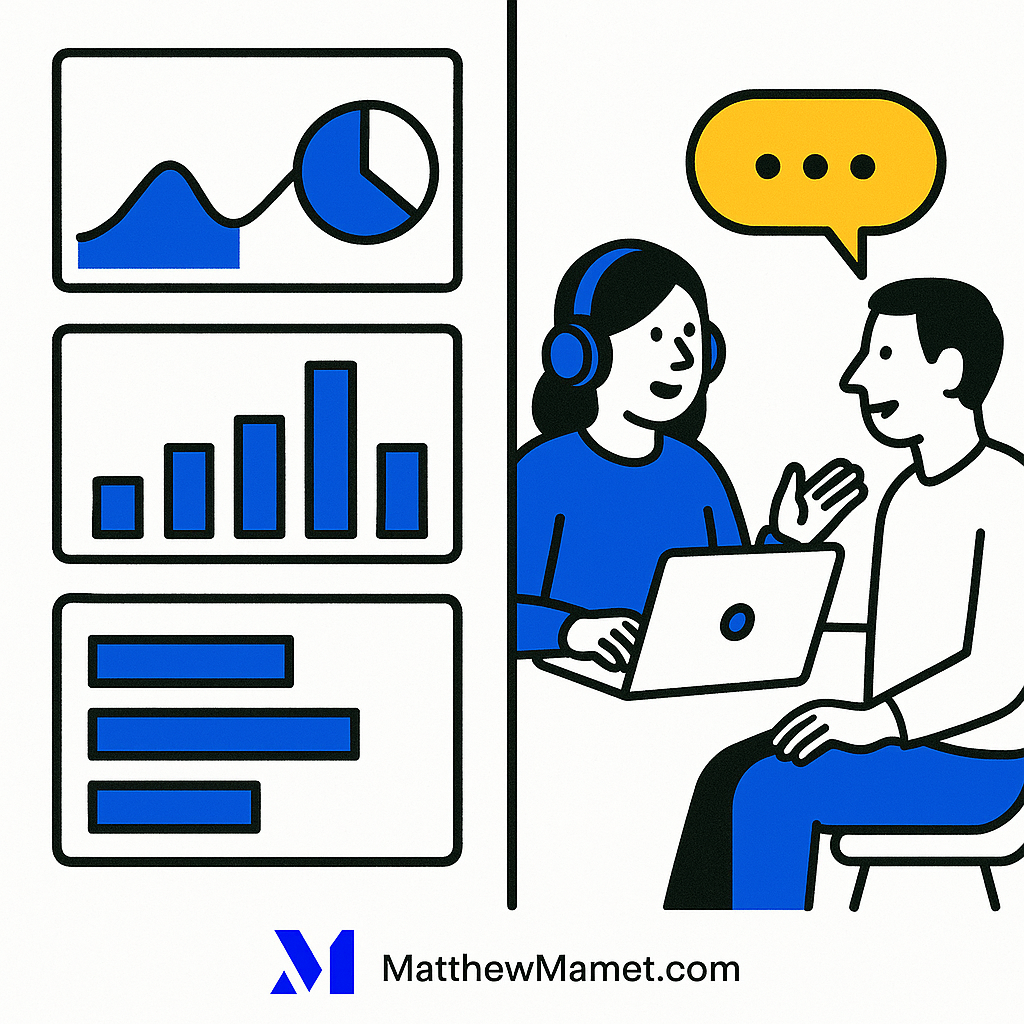Summary:
To effectively improve conversion rates, teams must integrate quantitative and qualitative insights, rather than relying on one alone. Quantitative data identifies where issues occur, while qualitative insights reveal the reasons behind them. Successful teams create a continuous feedback loop, using both data types to validate and prioritize changes. This approach prevents superficial fixes and ensures meaningful, lasting improvements by aligning user experiences with data-driven decisions.
Table of Contents
Zig Where the Herd Zags: Build an Insight Engine, Not a Reporting Factory
2. Qual to Discover What the Data Can’t Explain
3. Synthesize: Quant Surfaces, Qual Validates - and Vice Versa
Common Pitfalls (and How to Dodge Them)
2. Overcomplicating the Funnel
3. Mistaking Correlation for Causation
4. “We Already Know the Problem” Trap
Making Integration a Habit, Not a One-Off
Tools and Tactics That Actually Work
Using Quant and Qual to Improve Conversion
Most teams I advise have tried to “move conversion” at least three times before they call me. They’ve got dashboards coming out their ears, weekly metric reviews, AB tests teed up. Maybe they even run a user interview once in a while. Yet, a quarter later, nothing’s truly changed. Why?
Because quant tells you where the bottleneck is, but never the why. Qual tells you why users are tripping up, but not whether it matters in the big picture. Most teams lean on one or the other, not the pair. Worse, they run surface-level experiments, find “statistically significant” but useless lifts, or chase features because two users told them to.
Here’s the punchline: You need both, integrated tightly and relentlessly. If that feels like “twice the work,” you’re approaching it wrong. It’s about how - not how much - the work gets done.
Zig Where the Herd Zags: Build an Insight Engine, Not a Reporting Factory
I worked once with a marketplace platform where conversion on sign-up pages hovered at 6% for months. Product teams spun up dashboards, ran five AB tests, patched copy, even swapped button colors. No dent. In one week, we sat down and called ten lost users. Turns out, your “Create Account” form looked like a tax return and killed intent.
That’s not magic. That’s just putting your energy where reality lives: “What are users actually thinking and doing at the key conversion moments - and does it match what the data shows?”
Here’s how to build a loop that gets you real answers:
1. Quant to Find the Friction
- Map the funnel. Every step - from ad/view to conversion event - should be cleanly tracked. Don’t get lost in vanity metrics. Focus on the drop-off points.
- Segment your data. Who converts, who bounces? By device, channel, cohort, user type. Patterns don’t lie.
- Set up cohort analysis, not just events. When did conversion get better or worse - and what changed externally?
- Track what matters. For consumer, that’s often: visits to signup rate, signup to activation, trial to paid, paid to referral.
Quant is radar. It points you at where storms are brewing. Never stop checking it, but don’t make it your GPS.
2. Qual to Discover What the Data Can’t Explain
- Watch actual users try to convert. Use remote tools, but talk to people live too. Screen recordings are gold.
- Intercept lost users. Use a quick pop-up or a targeted email (“What stopped you from signing up?” in plain language).
- Go beyond surveys. Rely less on multiple choice, more on open text and “show me what you mean.”
- Collect user quotes. “I thought it would save my info - so why do I need to add it again?” becomes your roadmap.
This isn’t about running a “Voice of Customer” campaign once a year. It’s about embedding user realities in your weekly rhythm.
Ready to drive more growth & achieve bigger impact?
Leverage my 25+ years of successes and failures to unlock your growth and achieve results you never thought possible.
Get Started3. Synthesize: Quant Surfaces, Qual Validates - and Vice Versa
The magic’s in the back-and-forth. You spot a drop at “start checkout”? Queue up ten micro-interviews. Hear three folks trip over trust signals? Quantify: what % of users bounce after seeing that content?
If you’ve ever wondered “Should we fix this now?” - use qual to see if the pain is real, quant to see if it’s big enough to matter. You only need a handful of qualitative patterns to prioritize a fix, but the data will keep you honest on impact.
Quick Reality Check:
- Qual alone = loudest voices syndrome
- Quant alone = analyzing yourself into the void
See how I break down similar cross-checks in how to build high-performing teams or when navigating executive interpersonal dynamics. Pairing insights keeps teams moving forward, not sideways.
Common Pitfalls (and How to Dodge Them)
1. “Data Silo” Syndrome
Many teams have analytics, research, and product all running different “conversion studies.” All you get is a backlog of half-baked findings. Create a single insight pipeline - everyone brings a piece, but synthesis is communal.
2. Overcomplicating the Funnel
You don’t need twenty metrics to know what step is broken. Pick the 2-3 that matter, and get to real improvement before optimizing the rest.
3. Mistaking Correlation for Causation
Just because people who use your search bar convert higher doesn’t mean the search bar drove conversion. Use qualitative to challenge your A-to-B thinking.
Ready to drive more growth & achieve bigger impact?
Leverage my 25+ years of successes and failures to unlock your growth and achieve results you never thought possible.
Get Started4. “We Already Know the Problem” Trap
The moment you hear “We just need to tweak the copy/UX” from someone who hasn’t seen the data or heard from users, pause. Easy answers rarely survive contact with reality.
Check out why following the herd doesn’t work in leadership for more on cutting through wishful thinking.
5. Paralysis by Qual Insight
Endless user quotes don’t create action. Develop a system for ranking qualitative insights by frequency, severity, and potential impact on key metrics.
Making Integration a Habit, Not a One-Off
You want your team to cycle between quant and qual so routinely it feels odd to do just one. In my coaching work, execs often start by “owning analytics” or “owning research” - but the high performers create rituals around rapid synthesis.
Here’s what this looks like on the ground:
Weekly
- Review funnel metrics and flag the sharpest drop-off
- Assign a “conversion detective” to watch 5-10 real sessions for that step
- Pair up: numbers person + people person present back together
Monthly
- Pick a conversion moment to deep-dive (signup, add-to-cart, etc.)
- Run a rapid qual sprint - user calls, open feedback, live intercept
- Prioritize next build/test with both streams in mind
Quarterly
- Revisit North Star metrics - do they still align with the conversion behaviors that matter?
- Weed out local maximas and invent new ideas with both lenses. See breaking out of the local maxima for more.
Ready to drive more growth & achieve bigger impact?
Leverage my 25+ years of successes and failures to unlock your growth and achieve results you never thought possible.
Get StartedTools and Tactics That Actually Work
For Quant
- Simple cohort reports - Mixpanel, Amplitude, or raw SQL in a pinch
- Funnel visualizations that show volume, rate, AND conversion lag
- Segmentation tools that let you slice fast (new vs repeat, device, traffic source)
For Qual
- Usability hubs - UserTesting.com, Lookback, simple Zoom calls recorded
- In-product poll/feedback - Hotjar, Typeform with open-ended triggers
- Real-time session replays - FullStory, Smartlook (don’t just rely on stats)
Most important: Don’t wait for “big enough” sample sizes. Five is often enough for qual; reliable patterns show up early. For quant, focus on trends, not absolutes.
Using Quant and Qual to Improve Conversion
| Step | Quantitative Measure | Qualitative Tactic | Action This Unlocks |
|---|---|---|---|
| Top funnel analysis | Bounce rate by traffic source | Ask drop-offs what confused them | Reprioritize messaging or targeting |
| Signup conversion | Conversion by device/type | Watch new users try and fail | Remove friction, clarify value prop |
| Abandoned checkout | Cart abandonment % | Call lost users, review sessions | Simplify checkout, address hesitations |
| Trial to paid | Paid conversion by cohort | Deep interviews with churned users | Tweak onboarding, add contextual nudges |
| Referral step | Referral rate by flow variant | Live test of sharing flows | Remove blockers, juice incentives |
Ready to drive more growth & achieve bigger impact?
Leverage my 25+ years of successes and failures to unlock your growth and achieve results you never thought possible.
Get StartedBuilding an Insight Muscle - Not Just Running a Playbook
If you’ve stuck with me this far, ask yourself: Is your team practicing this loop, or just “doing research” and “pulling dashboards” on occasion? When a conversion rate sags, can anyone on the team say what the biggest bottleneck is - what users say about it AND what the numbers show?
This isn’t about spending harder or “adding more process.” It’s about raising your team’s conversion IQ by forcing cross-pollination. The most effective teams I’ve seen are relentlessly curious about what the numbers can’t say, and laser-honed on validating what users say with quant.
Practically, that means every change you make gets a one-two check: Do the numbers shift, and can a user who knows nothing about your platform explain what’s different? When both align, that’s when you get durable lift - not just fleeting wins.
Final Thought: Don’t Settle for One Lens
Everyone gets stuck in their own favorite comfort zone - some get lost in data, others default to anecdotes. Improving conversion rate isn’t about being a quant person or a qual person. It’s learning to spot when each alone is lying to you, and never betting an important change without the other.
If you’ve been spinning on the same conversion issues for months, chances are your “system” is feeding you half the story. You don’t need heroic work. You just need to close the loop, get specific, and throw away most assumptions before you start.
Get out of the dashboard. Get closer to users. Bring what you learn back to the whole team. That’s where real, lasting improvement lives. What’s your team missing today - numbers, stories, or just the glue in between?
Ready to drive more growth & achieve bigger impact?
Leverage my 25+ years of successes and failures to unlock your growth and achieve results you never thought possible.
Get Started



